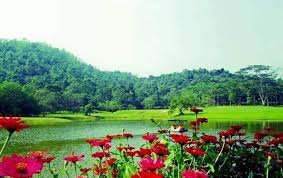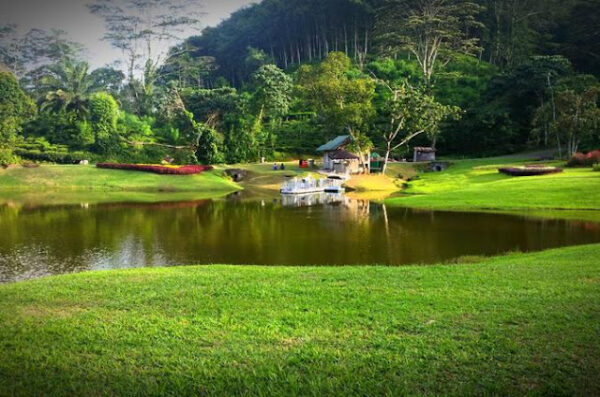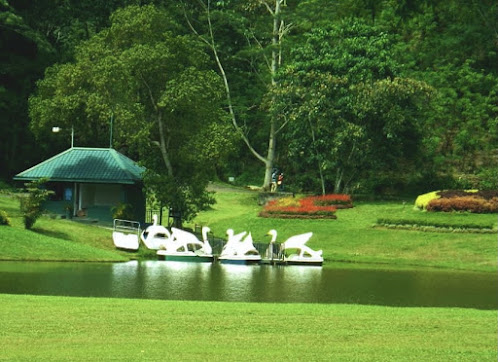Hidden Eden in Seethawaka – treasure trove of nature – By Arundathie Abysinghe

 Nestled in the outskirts of *Avissawella, in Illukowita in close proximity to Thunmodara, alluring Sitawaka Wet Zone Botanical Gardens is a paradise on earth… Fresh mountain air, verdant forest with glimpses of breathtaking vistas… Pebbled paths with many rare plants and trees flanked by beautifully laden flower beds… A serene lake with a reflection of the flower beds and tall trees surrounded by verdant misty mountains… Panorama of the green canopy contrast with beautifully designed flower beds… A vast lake, the centerpiece of the Botanic Gardens contrasts with the blue-grey sky reflected in the clear waters… Visitors are enchanted watching fish, small as well as large, coursing through the lake, a therapeutic experience… The serene atmosphere of the Gardens offers splendor and serenity of a haven away from the hustle and bustle of the adjacent road…
Nestled in the outskirts of *Avissawella, in Illukowita in close proximity to Thunmodara, alluring Sitawaka Wet Zone Botanical Gardens is a paradise on earth… Fresh mountain air, verdant forest with glimpses of breathtaking vistas… Pebbled paths with many rare plants and trees flanked by beautifully laden flower beds… A serene lake with a reflection of the flower beds and tall trees surrounded by verdant misty mountains… Panorama of the green canopy contrast with beautifully designed flower beds… A vast lake, the centerpiece of the Botanic Gardens contrasts with the blue-grey sky reflected in the clear waters… Visitors are enchanted watching fish, small as well as large, coursing through the lake, a therapeutic experience… The serene atmosphere of the Gardens offers splendor and serenity of a haven away from the hustle and bustle of the adjacent road…
Visitors interested in hiking can climb the Summit Garden that offers panoramic views of the Botanic Gardens. After hiking uphill approximately half a kilometer, a magnificent view point, a unique feature of the Gardens with spectacular views of the surrounding mountain ranges can be reached. The highlight of the Summit Garden is the bed of multicolored roses with over 75 varieties of hues. Vistas from the Summit Garden is similar to a picture out of a postcard…
A gorgeous stream flows through the Gardens which sustains the existence of diverse types of wet zone plants.
The Botanic Gardens comprises an arboretum, a fernery, herbal garden as well as a rose plot at the summit. There is a wooden bridge which offers extensive vistas of the Gardens. Arjun trees (Terminalia arjuna known as “kumbuk” in Sinhala) with amber yellow barks provide a striking contrast to the green foliage…
Spread over an area of 43 hectares (106 acres), Seethawaka Botanical Gardens strives to conserve endemic flora that is highly sensitive and difficult to be grown elsewhere successfully.

The Gardens provides opportunities for eco-tourism as well as economic development as a model wet zone landscape development. The Gardens is visited by a large number of researchers, undergraduates of many universities in Sri Lanka as well as the general public.
Seethawaka Wet Zone Botanic Gardens predominantly consists of plants than flowers unlike most botanic gardens in Sri Lanka as this park was established as a center to conserve the endangered wet lowland forest flora for future generations. Seethawaka Botanic Gardens also serves as a research and conservation location for endangered and vulnerable endemic plant species in the *Sinharaja Rain Forest region.
The Gardens is also home to a large number of animals, birds and reptiles including several migratory birds.
Although, the Gardens is located in close proximity to Avissawella, it is named as “Seethawaka Wet Zone Botanical Gardens” as *Seethawaka was a historic kingdom.
The location of the Park was a fertile land where British planters had cultivated agricultural crops such as tea and rubber in the vast Seethawaka mountainous region. According to folklore, the location had been known as “Pannagula” during the British Colonial era. However, during the post-independence era, the area was mostly neglected…
Commenced in 2008 and completed in 2014, the Gardens was open to the public in 2015. The primary objective of setting up the Botanical Gardens was to establish a plant conservation center to conserve the endangered and endemic plants in the wet lowland forest (in Sri Lanka) for posterity. According to the plaque at the entrance of the Garden, it was declared open in 2015.
The Gardens can also be visited by elderly and disabled visitors as electric cars can be hired. The spacious restaurant is located close to the main gate, a boon to visitors to refresh after a trek in the Gardens.
Visitors can also enjoy boat rides in swan-shaped pedal boats at the man make lake, built using the natural water flow from the nearby hills while immersing in the splendor of the serene environment…
Location – Puwakpitiya – Thummodara main road at Illukowita adjacent to the Indikada Mukalana Forest Reserve at Avissawella

Image courtesy – travelwithuma.com & facebook.com
- Avissawella – Located approximately 48 kilometers from the commercial capital Colombo, Avissawella is also known as “Seethawakapura”.
- Kingdom of Kotte – Capital of Sri Lanka from 1415-1565 AD predominated by the reign of King Parakramabahu VI (1412-1467 A.D.). The Kingdom was attacked by external aggressors (the Portuguese) and internal dissidents. Hence, only meagre visible remnants testify the existence of a magnificent kingdom of yesteryear. Sri Jayawardenepura Kotte, commonly known as “Kotte” is the legislative and administrative capital of Sri Lanka. According to scholars, Kotte (derived from “kotuwa” in Sinhala meaning fortress) has originated from a fortress constructed by Nissanka Alagakkonara (also known as Alakeshwara, considered as the founder of Kotte).
- Kingdom of Sitawaka – A kingdom located in south-central Sri Lanka that emerged from the division of the *Kingdom of Kotte. Kingdom of Sitawaka had offered fierce resistance to the Portuguese who arrived in Sri Lanka in 1505.
- Sinharaja Rain Forest – Located in south-west, a forest reserve and biodiversity hotspot in Sri Lanka, Sinharaja is the country’s last viable area of primary tropical rainforest spanning an area of 18,900 acres (7,648 hectares). It ranges in altitude from 300 meters to 1,170 meters. There is endemic wildlife, including many species of mammals and butterflies, diverse types of insects, reptiles and rare amphibians, especially birds. The Rainforest is of international significance and has been designated a Biosphere Reserve and World Heritage Site by UNESCO.







